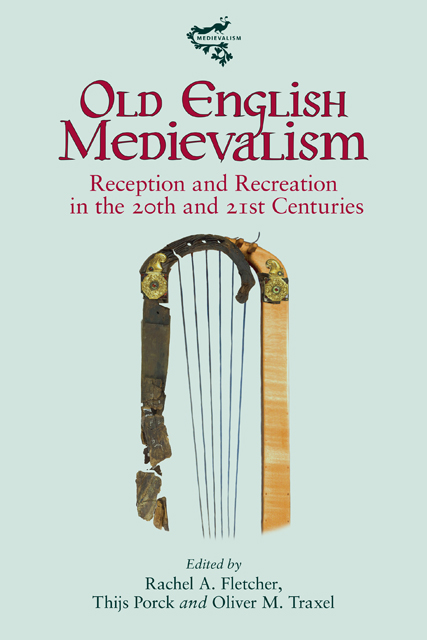Book contents
- Frontmatter
- Contents
- List of Illustrations
- List of Contributors
- Acknowledgements
- List of Abbreviations
- Early Medieval English in the Modern Age: An Introduction to Old English Medievalism
- I Reinventing, Reimagining and Recontextualizing Old English Poetry
- II Invoking Early Medieval England and Its Language in Historical Fiction
- III Translating and Composing in Neo-Old English
- IV Approaching Old English and Neo-Old English in the Classroom
- Bibliography
- Index
- Medievalism
4 - Old English Poetry and Sutton Hoo on Display: Creating ‘the Anglo-Saxon’ in Museums
Published online by Cambridge University Press: 17 December 2022
- Frontmatter
- Contents
- List of Illustrations
- List of Contributors
- Acknowledgements
- List of Abbreviations
- Early Medieval English in the Modern Age: An Introduction to Old English Medievalism
- I Reinventing, Reimagining and Recontextualizing Old English Poetry
- II Invoking Early Medieval England and Its Language in Historical Fiction
- III Translating and Composing in Neo-Old English
- IV Approaching Old English and Neo-Old English in the Classroom
- Bibliography
- Index
- Medievalism
Summary
This chapter analyses the meanings and effects of Old English poetry when presented alongside Sutton Hoo artefacts by the British Museum 2014–present, and with displays and landscapes at the National Trust Sutton Hoo site 2002–18. Old English poems in both spaces are extracts, mostly translated, mostly without reference to date or place of provenance. In one case the text is neither a medieval composition nor a translation although it is presented as such. Therefore, ‘Old English’ is used throughout this chapter as shorthand for fragmented, translated, neo, and new Old Englishes. Museums instrumentalise Old English as script and as replica. Poems are presented as the voices of lost individuals which direct visitors how to look. Such instrumentalisation of Old English suggests an anxiety about the capacity of objects or landscapes alone to signify – to speak – correctly, if at all, while relying on narrow readings of poetry. Resulting enmeshments of texts, objects, and place can be observed to ‘thicken’ museum spaces, inviting visitors to encounter early medieval culture in imaginative, embodied, affective ways.
The poem most often displayed with Sutton Hoo is Beowulf, revealing how museum practices and scholarship mirror each other (consider the veritable subgenre of ‘Beowulf and archaeology’ work). As Roberta Frank documents, scholars have debated the importance of bringing Sutton Hoo and Beowulf together since the 1939 excavation of the ship-burial with its lavish grave goods, now known as ‘Mound 1’. Frank discusses the difficulties in the ‘marriage’, particularly their differences in time and place. Mound 1 is dated to the early seventh century and proposals for Beowulf’s composition range across 500 years, with Sutton Hoo often invoked in support of earlier dates of the poem. Frank’s identification of the union as a ‘marriage’ reminds us to pay attention to its emotional stakes. One such emotional stake is in how the pairing is used to make claims about past and present identities. Because the British Museum and National Trust use the term ‘Anglo-Saxon’ in their displays, they are spaces which shape the valences of ‘Anglo-Saxon’ as a category in the British imaginary, as a marker of historical and ongoing nationhood or ethnicity.
- Type
- Chapter
- Information
- Old English MedievalismReception and Recreation in the 20th and 21st Centuries, pp. 71 - 92Publisher: Boydell & BrewerPrint publication year: 2022



